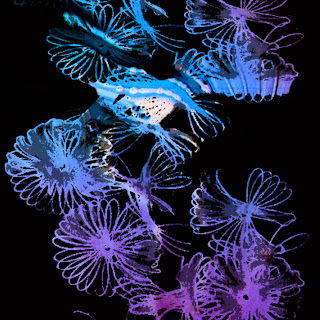Georges Rousse constructs installations through different illusions. I thought this would work well with my idea of taking the shapes from my 3D form photography and layering these over the top of my mixed media photography, adding new elements of colour. These worked effectively in visualisations, but the designs with more structured elements were too mechanical so they will not be part of my high end collection.
This gave me the idea of creating mono-prints to put over the top of my photographs in the shape of the patterns in my 3D form photography. This became a way of losing control over the outcome of the image as I did when creating my 'glitches' on Justin Windle's website because I apply the ink straight onto the paper.
The scale of the mono-print wall murals worked once put into an interior setting but the contrast between the black lines and my photography appears too strong. I did research into companies which create high end wall panels as I felt that my images could also work within other interior settings such as hotels and office spaces. I discovered Maxalot which is a company that helps young digital artists establish and promote themselves, a lot of which create designs for walls. Through this I found Eno Henze who sells his wall panels through the Maxalot website.
The piece below is one of Eno Henze's wall panel designs for sale on Maxalot.
I also became interested in Nhow Berlin Hotel; the whole of it's interior is designed with creativity in mind. It also made me think of creating coordinates to go with my designs as part of my design collections. Both high end and mid- end companies use these so they would work well in both of my collections; I should consider coordinating wallpaper/ wall panels and other objects such cushion covers and curtains.
The image below is from Graham & Brown's website, I thought it was important to do research into coordinates for both high end and mid- end companies. Graham & Brown offer their designs and all coordinates in a collection, in a number of different colours; I must consider this when creating my mid- end design collection.
I learnt during my internship with Graham & Brown that wallpaper companies use screen printing as their production process, as it is cheap, fast and they always work to the dimensions 52 by 53 cm. I don't need to work to these dimensions when creating my designs for my high end collection as they will be digitally printed, which means I can work to any scale. This makes the process much more expensive but more suited to my designs as they have a lot of colours in. When mid market wallpaper companies create a design they must separate all the colours before being put onto screen which means the more colours and detail you use, the more complicated the design becomes for testing and production. Therefore my photography would not be able to be used in any of my mid market designs as it would be unsuitable for screen printing.
Graham & Brown. Desire. [Online image] [Accessed on 15 November 2013]

















































